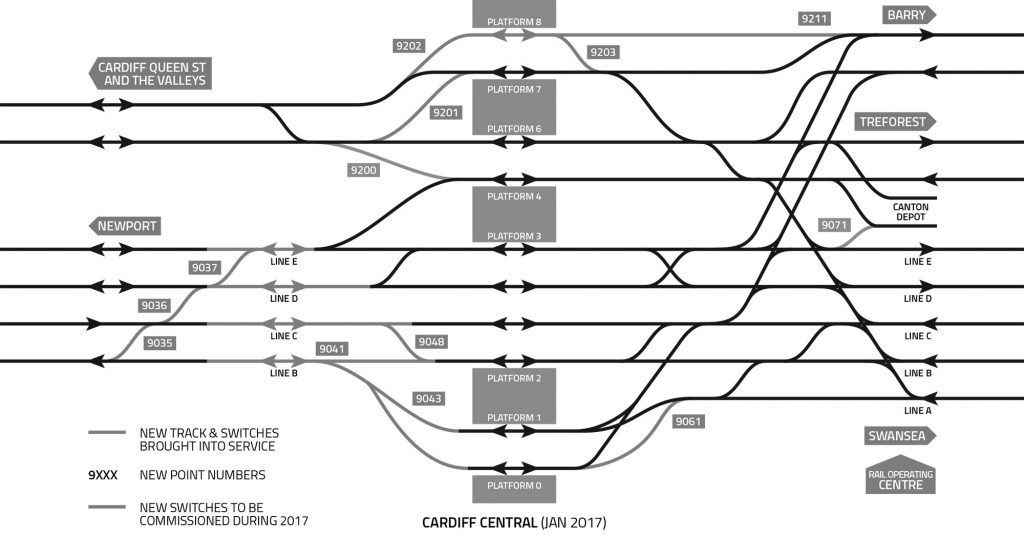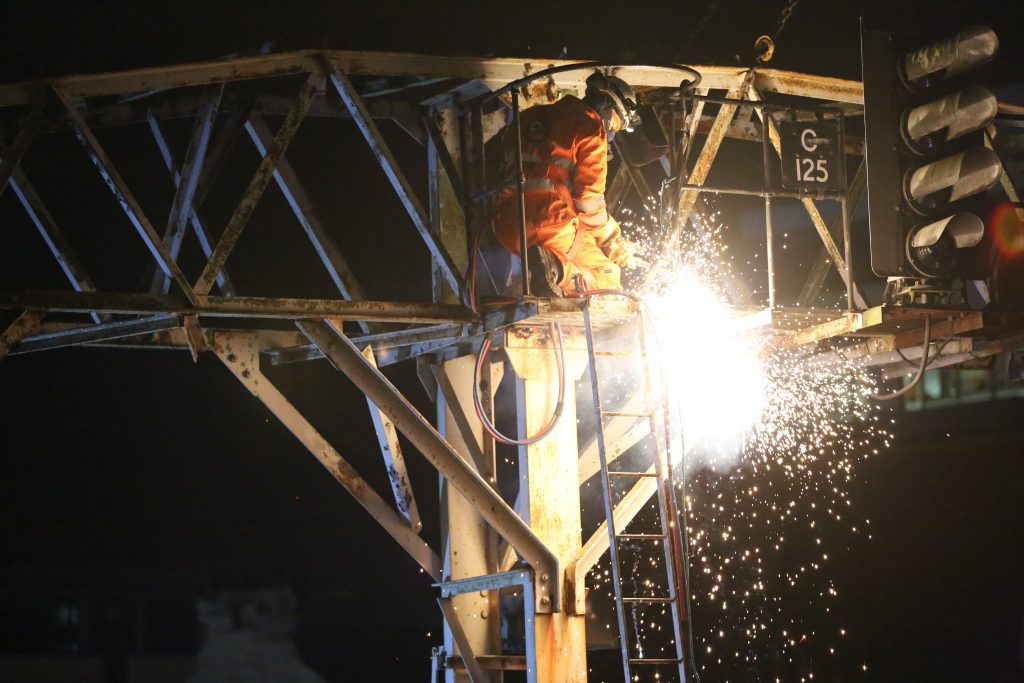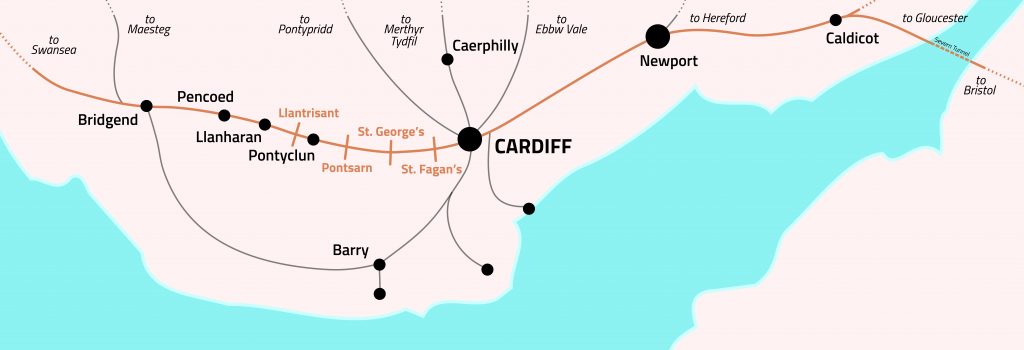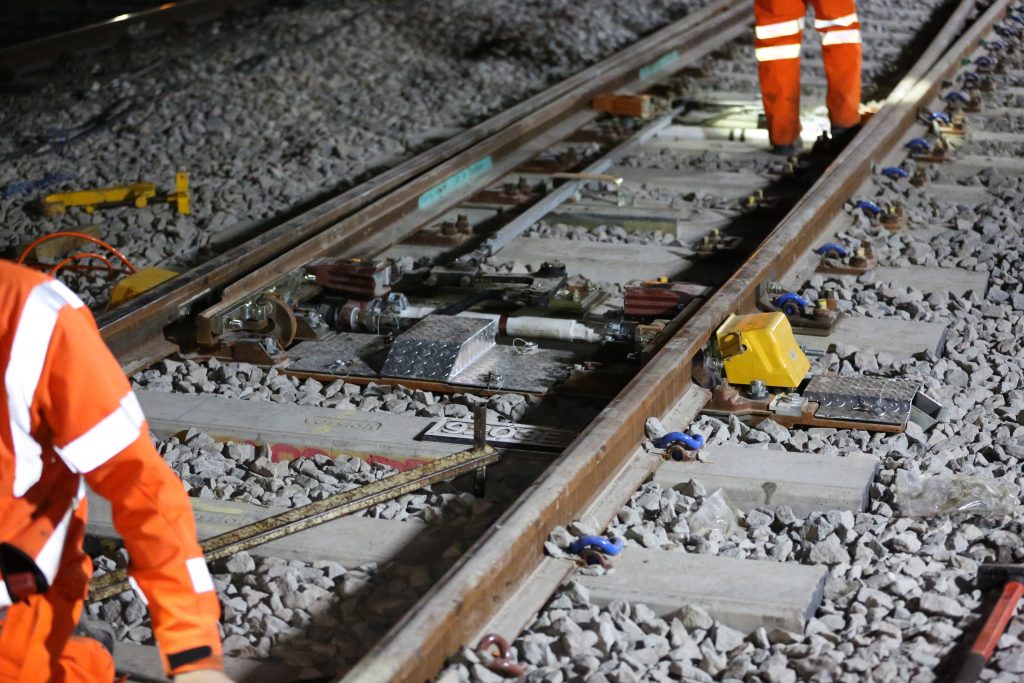The fifth and final phase of the £300 million Cardiff Area Signalling Renewals (CASR) project, Network Rail’s biggest ever signalling commissioning in one phase, was completed over the festive period bringing significant improvements to capacity and flexibility at the busiest station in Wales.
Cardiff Panel Signal Box, which has controlled movements in the station area for fifty years, was switched off and replaced with a new signalling system controlled from the Wales Rail Operating Centre (WROC).
Changing fortunes
Cardiff Panel Box was opened in 1966, at a time of ongoing social and economic change in South Wales. With the decline of the traditional deep mine coal industry in the Welsh valleys, the long coal trains also became history. Those employed underground or in support jobs were forced to look elsewhere for employment, changing the role of the valley towns to that of dormitories for people working in Cardiff. Indeed, the Welsh capital offers attractive job opportunities for those willing and able to commute into the City.
Despite the cutbacks in passenger services and rationalisation of the infrastructure in the 1970s, some passenger services in the valleys managed to survive and, a decade later, the whole outlook was starting to look so much better.
It was in the autumn of 1982 that John Davies, a career railwayman with a flair for marketing, took up the role of British Rail’s passenger manager for South Wales. A man with a vision who understood what railways could do for people and the local economy, John and his team set about revitalising the Valley line passenger services that culminated in the introduction of Sprinter/Pacer trains and the reopening of several lines and stations in the area. This was the genesis of the Valley lines services operated today by Arriva Trains Wales.
The boom in passenger numbers in the twenty-first century has led to aspirations to run more trains than ever through Cardiff Central, but the shortcomings of the little-altered 1966 track layout and signalling meant that this required a number of infrastructure improvements to be delivered:
- Two new platforms;
- Capability for 16 trains per hour (currently 12) on the Cardiff Central to Queen Street Valley lines corridor;
- New crossovers to permit Down main line trains to turn round in the low numbered platforms;
- Full bi-directional signalling on all platforms;
- Automatic Route Setting.
No doubt much has been doneover the years to life extend the signalling installation, but a major factor that determines the overall life expectancy is the condition of the cables and wires. Certain types of insulation material used in signalling circuits may degrade over a long period of time. Care has to be exercised when disturbing a hard-wired relay interlocking that is 50 years old to avoid disrupting the insulation, thereby compromising electrical separation of safety circuits. Consequently, the extensive interlocking alterations necessary to implement the above proposals have been developed as an integral part of the resignalling project.
Platform 0 was, in fact, created in 1999 using the existing signalling, which meant that trains were only able to arrive at the platform using shunt routes with no passengers aboard. The brand new Platform 8 was constructed a year ago in conjunction with the new south side entrance to the station but, for reasons explained above, could not be cut into the existing signal interlocking.
Hub and Spoke
Under the ‘Hub and Spoke’ arrangement, Network Rail is the hub as CASR principal contractor, and the spoke contracts are:
- Atkins – design, build and test the signalling of all five phases of the CASR project;
- Atkins – design, build and test the new power and distribution system including all new points heating; » Balfour Beatty – permanent way, track, switches & crossings (S&C); » BIRSE (now part of Balfour Beatty) – civil engineering;
- Siemens – telecommunications; » BAM Nuttall – Cardiff Queen Street and Cardiff Central station enhancements;
- Network Rail Maintenance Delivery Renewals – responsible for multiple track, S&C and signalling Stage works.
- As part of its work, Atkins used the following sub-contractors:
- Siemens Rail Automation – Westlock interlockings and Westcad workstations (Newport and Port Talbot fringes);
- Alstom (formerly GE Transportation) – Modular Control System (MCS) workstation hardware, VHLC Logic Controller hardware, plus provision of Automatic Route Setting (ARS) and Signaller simulator through Hitachi Information Control Systems Europe (HICSE) (formerly TRE);
- Unipart – lineside equipment location cases and relocatable equipment buildings (REBs), plus plug-coupled cables;
- Henry Williams – functional (power) supply points (FSPs).
Once the last trains had departed
At 22:00 on Christmas Eve, engineering possessions were taken that covered the South Wales main line from the Newport end, through Cardiff Central station to the Port Talbot East workstation fringe at Llanharan.
In addition, further possessions took in the Valley lines from Cardiff Queen Street (exclusive) through Cardiff Central to Cardiff West End and the Barry/Vale of Glamorgan lines.
At this time, Cardiff Panel Box and St Fagans Gate Box were decommissioned. The power isolation of the old signalling feeders was completed before on-track workers and back-room technical teams moved in to connect up the new equipment and recover the old.
Cardiff East Junction on the Newport side was completely remodelled and track renewed on lines C and D.
Meanwhile, work progressed eastwards from Llanharan with civil engineering teams recovering signal gantries, cantilevers and straight posts. Signal installation staff were following up un- bagging new signals, un-shielding Automatic Warning System (AWS) track inductors, and recovering all redundant lineside equipment.
This was, in turn, followed by outdoor testing staff liaising with their counterparts in the WROC to ensure the correct functioning and correspondence of all signals, points, ground frames, train detection, AWS and Train Protection and Warning System (TPWS) equipment.
Axle counters had been installed and rehearsal tested prior to 24 December as this method of train detection is independent of the track circuits that were still in use at the time by the old signalling system.
Large volumes of vegetation clearance was undertaken to ensure compliant sighting of all new signals.
Finally, at the fringe with Port Talbot signal box, data links had to be commissioned linking the new Miskin Westlock Central Interlocking Processor (CIP) (one of four new CIPs on this phase of CASR) with the existing Port Talbot Solid State Interlocking (SSI). Completion of this work was an early priority to ensure handback of the Port Talbot fringe by 04:00 on Tuesday 27 December, allowing trains to recommence operating between Bridgend and Swansea.
27 to 29 December
With all civil engineering and track work on lines C and D completed and signal gantries recovered, the signal installers and testers made their way to Cardiff Central station to undertake all the usual outdoor work of installing and testing the equipment as described above for the western leg. Additionally, all new car stop markers, GSM-R signage, Train Ready to Start (TRTS) plungers, signal ‘OFF’ and ‘RA’ (Right Away) indicators were unveiled on all platforms. Finishing touches were applied to the lighting, waiting area, staircase, lifts, and staff office of the new Platform 8.
Other Signalling & Telecommunications (S&T) works included the re-control of the Manually Controlled Barriers (MCB) level crossings at St Fagans, (converted from MCB to MCB-CCTV), Llantrisant, St George’s and Pontsarn, to a new Level Crossing control desk. Signage and road markings were updated as required.
Telecommunications work included substantial alterations to the GSM-R system (cab to signaller radio), hundreds of new circuits for the signalling system and operational communications, 127 new signal post telephones (SPTs) and the recovery of 84 old ones. A significant upgrade was required for the Customer Information System (CIS) and inputs to DARWIN (National Rail’s real time train information), Train Running Under System TOPS (TRUST) and Control Centre of the Future (CCF) systems.
Within the WROC, one of the largest signalling data changes ever undertaken was progressed, involving around 126 discrete data uploads. The HICSE TREsa ARS product was added to all three workstations, having been used in revenue earning service on the Valleys workstation since June 2014.
Wholesale recoveries of existing signalling equipment were also undertaken.
The new signalling was fully described in issue 137 (March 2016) but, to briefly recap, the signaller interface consists of MCS workstations (Cardiff Valley, Cardiff main line, and Vale of Glamorgan), interfacing via Control System Gateways (CSGs) to the Westlock Central Interlocking Processors (CIPs). The CIPs communicate with trackside function modules via SSI data links. Train detection utilises Frauscher FAdC axle counters.
Although the full signalling system was scheduled to be handed into service at 04:00hrs on Tuesday 29 December, this interim handback was delayed (for reasons still under investigation) so that services would resume at 08:00 with the planned full Valley line service using platforms 6, 7 and 8. Due to the planned ongoing remodelling of the throat of platforms 0, 1 and 2, services on the main line were restricted to platforms 3 and 4 and accessed via line E to facilitate a limited service to run between Bridgend and Newport.
Track works
Within the area of the festive blockade, twenty new point ends were commissioned. Points 9041 and 9043 were installed, using a Kirow 250 crane, tested and commissioned during this period. All the other point ends had been previously installed during possessions between Christmas 2015 and November 2016, the points having been secured out of use with detection only cut in to the relay interlocking. During the blockade, point detection circuits were transferred to the new Westlock interlockings, and the control circuits and drive mechanisms brought into service.
Within the constrained area of the station layout, various switch types, including type NR60D, CVs, DVs and EVs are deployed. Rail Clamp Point Locks (RCPLs) and In Bearer Clamp Locks (IBCLs) are used extensively.
SO back or supplementary drive units have been added to the longer switches with IBCLs.
Overall, the extensive track work during the blockade included:
- Full remodelling of the east throat; » Lines A, B, C, D, and E – fully relayed with 1,250 metres of plain line;
- Modifications to points 9056, 9074 and 9083;
- Changed 74 point timbers over seven point ends;
- Stressed and tamped Up Main at Rumney river bridge to remove a TSR;
- Quality tamp of Up and Down Reliefs at eastern end;
- Recovery of 828 trap points at Cardiff West to plain line;
- Recovery of Insulated Rail Joints
(IRJs). These provided the electrical separation of adjacent track circuits but are now redundant as train detection is provided by axle counters. The opportunity of the possession was taken to remove as many IRJs as possible.
Over New Year
Once the signalling had been handed back on the morning of the 29th, possessions were maintained on platforms 0, 1, 2 and 3 for track remodelling to be completed at Cardiff East throat, including the relaying of lines A and B and installation of points 9041 and 9043, giving access to platforms 0 and 1, and the relaying of line E.
Engineering Possession Reminders (EPRs) were applied on the otherwise now fully operational workstation screens for the areas remaining under absolute possession. With the track and associated signalling works finally completed, this part of the station was handed into operational use at 02:30 on Tuesday 3 January for the passage of route proving trains. This concluded at 03:55 allowing the first trains to enter service from 04:00, thereby bringing to a finish the extensive engineering works over the holiday period.
Two new crossovers coming soon
In the tight timescales of the festive blockade, it was deemed not possible to include the installation and commissioning of two new crossovers. At the eastern end, points 9200A/B provide access at Platform 4 to/from Cardiff Queen Street and the Valley lines. Platform 4 is ostensibly a Valley line platform but is currently used for other services. It is planned to commission this crossover two weeks before Easter 2017.
In June 2017, a new crossover at the western end, 9071A/B, will provide direct access at Canton depot to/ from Platforms 0, 1, 2 and 3 via line E, thereby obviating the current conflicts via the Barry Relief lines.
Thanks to Christian Irwin, Network Rail programme manager, and Conor Linnell, project director, transportation at Atkins, for their help with the preparation of this article.
Written by David Bickell






